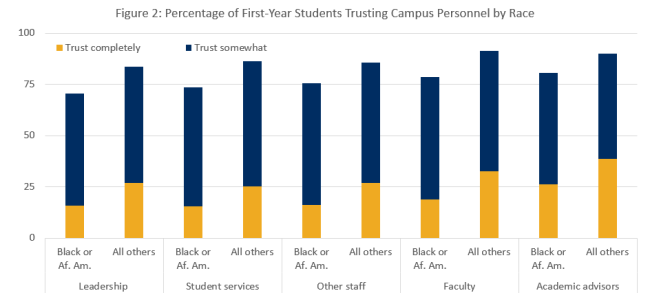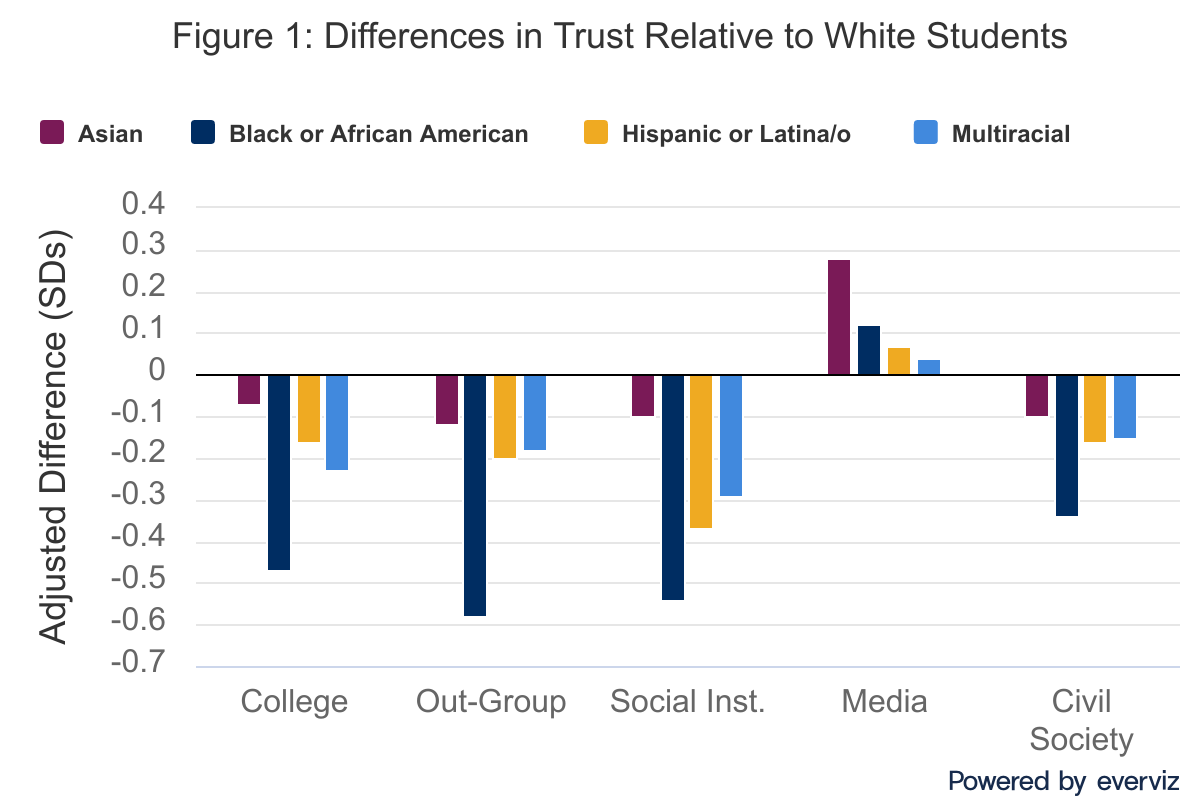You have /5 articles left.
Sign up for a free account or log in.

"The Trust Gap Among College Students," by Kevin Fosnacht and Shannon Calderone
Students of color have “substantially less trust” in their colleges compared to their white peers, according to a new report by the Indiana University Center for Postsecondary Research.
Kevin Fosnacht, associate research scientist at the center and co-author of the report, said the college trust gap between Black and white students, at 0.47 standard deviations, was particularly large. The disparity in perspectives was described in the report as being “of sizes rarely seen in education research.” There was an even larger gap (0.58 standard deviations) between Black and white students’ “out-group trust,” which in this case refers to their trust in individuals who are of different races than themselves, the report said.
To measure the trust gap, the researchers used white students' responses as a baseline, then determined how far above or below the average trust levels of students of color were from this baseline. Based on prior higher ed research, standard deviations of less than 0.10 were marked as "trivial," differences of 0.10 to 0.29 as "small," 0.30 to 0.49 as "medium," and greater than or equal to 0.50 as "large," Fosnacht said.
 The report, published on Feb. 18, is based on about 8,350 undergraduate responses to the 2020 National Survey of Student Engagement, or NSSE, an annual project of the center. The undergraduates surveyed attended 29 different colleges and were asked questions related to their trust in their college over all and in specific leaders and stakeholders at their institution, in addition to questions traditionally asked on the NSSE, Fosnacht said.
The report, published on Feb. 18, is based on about 8,350 undergraduate responses to the 2020 National Survey of Student Engagement, or NSSE, an annual project of the center. The undergraduates surveyed attended 29 different colleges and were asked questions related to their trust in their college over all and in specific leaders and stakeholders at their institution, in addition to questions traditionally asked on the NSSE, Fosnacht said.
Shannon Calderone, a professor of educational leadership at Washington State University and co-author of the report, said the findings about Black students’ lack of trust “speaks to the alienation and lack of sense of belonging” historically felt by students of color at colleges. Despite many administrators creating initiatives, offices and policies directed at improving diversity, equity and inclusion in recent years, these students continue to distrust college leaders, especially if those leaders are not people of color themselves, Calderone said.
“It’s a relatively disappointing finding, obviously, given the commitments,” she said.
Fosnacht said the report also focused on the varying levels of trust that first-year students had for specific types of college staff members, including leadership, student services staff members, academic advisers and faculty members. Across all racial groups, students expressed the most trust for faculty members and academic advisers, while college presidents, provosts, deans, board members and other leaders face “the largest legitimacy crisis among college personnel types,” the report said.
Calderone said that this trust “crisis” can be explained by the “power differentials and power dynamics” that exist between college leaders and students. Oftentimes students feel absent from decision making and that their opinions are not valued by leaders, which, naturally, can reduce trust levels, she said.
“When we think about leadership, these are the ones who set the rules and establish the conditions which students have to live under,” Calderone said. “One of the things that I think about a lot is, are students getting enough of a voice in the larger campuswide conversation, particularly students of color?”
Stuart Rhoden, an instructor at Arizona State University who has researched Black high school students' institutional trust and its impact on academic achievement, said that administrators' inclusion of student voices in decision making needs to be "genuine" and "authentic" or else it can damage students' trust in college leadership.
"If all I’m doing is having you sit at the table to say you’re sitting at the table … that can do more harm than good," Rhoden said.
The Black students surveyed by NSSE exhibited even less trust for all college personnel than their non-Black peers, the Indiana University report said. While 84 percent of non-Black first-year students said they “completely” or “somewhat” trust their college leadership, only 71 percent of Black first-year students said the same, according to data provided by Fosnacht in an email. Nine percent of Black first-year students surveyed said they don’t trust college leadership “at all,” versus only 3 percent of non-Black students, the email said.
Shaun Harper, a professor and executive director of the University of Southern California's Race and Equity Center, said the neglect college administrators have historically shown to Black students' needs and demands can explain their deep mistrust of college leaders. Harper said the widespread calls for institutional changes currently being made by Black student activists at colleges across the country are a reflection of them still not being heard and having their concerns dismissed or ignored.
"Why would Black students trust campus leaders who repeatedly fail to hold themselves and others throughout the institution accountable for demonstrable progress on racial equity goals? They shouldn’t," Harper said. "On many campuses, the exact same things that were on lists of demands Black students issued to campus administrators in the 1960s … appear on lists of demands that Black students have issued over the past five years, almost verbatim."
Rhoden said one way to expand the research on Black student trust would be to measure the recent survey responses against the level of trust previous generations of Black students had in college leadership.
According to the NSSE report, Black first-year students were also less likely to trust faculty members; 79 percent said they “completely” or “somewhat” trust them, while 92 percent of non-Black students trust their professors, the email said. This trend, which the report said was “worrisome” and deserves “scrupulous attention,” was also consistent for Black students’ trust in academic advisers and student services staff members.
Rhoden said the trust factor could be improved by faculty members and support staff members fostering better relationships with students and making them feel comfortable about reaching out for support and letting them know that their goals and abilities will be encouraged and validated.
The report also considered the impact of the coronavirus pandemic on students' views and experiences, which put college leaders’ decisions and regard for student health and well-being under a microscope during 2020. The survey results were partly collected after campuses shut down in-person learning in response to the pandemic and sent students home, Fosnacht said. The majority of the NSSE data was collected from February to early March 2020. However, some responses were gathered from late March to mid-May, allowing Fosnacht and Calderone to examine differences between student trust before and during the pandemic-related disruption.
The pandemic has tested administrators’ ability to effectively communicate campuswide decisions that are often unpopular, such as stances on in-person versus online learning, opening residence halls, providing tuition and room and board refunds, and disciplining students for conduct that can increase the risk of spreading COVID-19.
Students who completed the survey after the campus shutdowns expressed slightly higher levels of trust in their colleges over all but slightly lower levels of trust for college leadership specifically, compared to students who responded to the survey before the disruption, Fosnacht said. About 73 percent of students surveyed after the disruption said that they trusted their college leaders “completely” or “somewhat,” compared to about 79 percent of students before the pandemic, according to data provided by Fosnacht.
Students with disabilities were also surveyed, and despite multiple reports of students with disabilities being denied support or accommodations from their colleges during the pandemic, the small number who responded to the survey after COVID-19 disruptions actually expressed a substantial increase in trust in their colleges, the report said. Students with disabilities and those who selected "prefer not to respond" when asked about disability status during or after the pandemic disruption showed levels of trust in their colleges that were 0.28 standard deviations higher than students in these groups surveyed before the pandemic, the report said. Fosnacht said this finding was surprising and unexpected.
These results suggest “institutions looked out for or met the needs of disabled students in uncertain times,” the report said. However, statements by advocates for students with disabilities and research on their well-being during the pandemic directly contradicts this finding. For example, a survey of nearly 30,000 undergraduates conducted by the Student Experience in the Research University Consortium found that students with disabilities were less likely to feel supported by their university during the pandemic.
Krista Soria, an assistant director for the consortium and director of student affairs assessment for the University of Minnesota, said in an email that her research on students with disabilities makes “it clear that those students are really struggling” during the pandemic. Soria noted that for the Center for Postsecondary Research report, only about 40 students with disabilities responded after the pandemic disruption, compared to about 500 students who responded before the pandemic, according to NSSE data provided in an interactive database. (These counts do not include those who said they prefer not to share their disability status, or those who did not mark their status.)
“I don't think it is fair to make sweeping conclusions about students with disabilities given the super small sample size of the group during the pandemic,” Soria wrote. "Students with disabilities have significantly lower satisfaction with the support they received from instructors to transition to online classes, feel less valued as individuals and have a lower sense of belonging on their campuses, and less supported overall by their institutions during the pandemic."
Fosnacht agreed that the small sample of students with disabilities surveyed after the pandemic disruption might have impacted the results. He said the finding should be regarded as “suggestive” rather than “conclusive.” The responses from students with disabilities vary based on the college they attend and what learning modality they prefer; it’s possible that some students with disabilities had better experiences with remote learning versus in-person instruction, Fosnacht said.
“It might be very contextual to the school -- how much were faculty accommodating them,” he said. “There might be some advantages to online learning for that specific population.”




